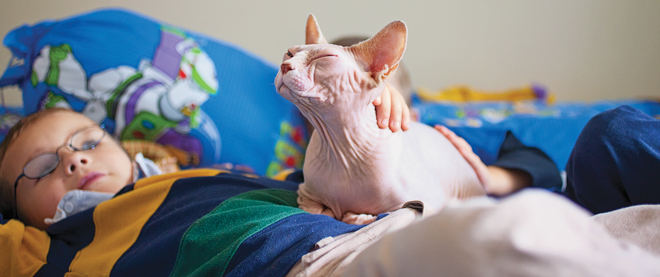Canadians love to cuddle up to their furless friends
Even though they stink, they’re ugly and they’re high maintenance
Photography by Jenna Marie Wakani
Share

A self-professed “neat freak,” Sandra Fargiorgio used to vacuum the cat fur from the carpet every day. She grew tired of the chore, so when her cat died, the mother of three from Milton, Ont., decided to get a new kind of pet, one that wouldn’t leave tufts of fur on her black pants.
She found a breeder of hairless cats—called sphynxes—and the family drove 3½ hours to pick up a light-skinned kitten named Woody. A year later, they got Gilbert, who looked like a little gremlin. “We have a lot of family friends that think we’re really weird,” she says, adding that guests sometimes think the family has a couple of rats running around the house. “People are just kind of grossed out by them because of the way they look.”
But Fargiorgio and her family aren’t alone in their love of hairless pets. It turns out more Canadians than ever before are snuggling up to the naked epidermis of a hairless animal. Aside from sphynxes, there are hairless guinea pigs—also known as skinny pigs—hairless dogs, even hairless rats, mice and hamsters. Both skinny pigs and sphynxes—obviously vulnerable to the cold—have Canadian connections: the sphynx gene can be traced to hairless cats found in a Toronto alleyway in the 1960s, while skinny pigs first turned up in a Montreal lab in 1978.
Hairless pets are now produced by private breeders, and there are dozens in Canada that sell hundreds of animals each year. John Macpherson has sold well over 100 sphynxes in the Edmonton area in the past five years. They strive to perpetuate the genetic mutations that introduced hairlessness as a hereditary trait. It can come with health problems, but lovers of bald animals insist the creatures have highly redeeming personalities that make it all worthwhile. “I view these cats as a gift from God,” says Lou Ann Vennettilli, a sphynx breeder from Wyoming, Ont., who currently lives with six cats. “They are not like any animal that you have ever been around,” she says. “They’re very different and very loving.”
Despite their much-lauded personalities, sphynx cats and other hairless pets often require more care than their fluffier friends. Fargiorgio dresses her two sphynxes in turtlenecks, since their furless bodies are susceptible to changes in temperature. Their hairlessness also makes it more difficult for them to clean themselves. Unwashed, sphynxes start to stink; Vennettilli compares it to the smell of “potato water.”
The hairless guineas come with their own hygiene issues. They maintain a higher body temperature to make up for their lack of fur, and that means they are more active and consume more food than hairy guinea pigs, says Stuart Cheese, whose 14-year-old daughter Opal has two of them, named Peanut and Butter, and another she’s trying to sell. Naturally, their high food intake translates into high digestive output. “Sometimes they get smelly from pee or poo or whatever,” says Opal.
Mike Bridges, a factory worker in Guelph, Ont., who breeds guinea pigs in his spare time, says skinnies are susceptible to sunburns, dry skin and—yes—bouts of smelliness. After he bought his first one, he came home after a long night shift and fell asleep with him on the couch. “I’ve got a thing for the hairless animals,” says Bridges. “They look so helpless and nice.”
Hairless animals tend to have shorter lifespans by about two to three years than shaggier specimens. Sphynxes are also more likely to suffer from hypertrophic cardiomyopathy, a heart condition that can lead to sudden cardiac arrest, says Vennettilli. Parvathi Basrur, a retired animal geneticist and professor emeritus with the Ontario Veterinary College at the University of Guelph, says the genetic mutation that causes hairlessness can also result in dental deformities and protein deficiencies. In the early 1980s, Basrur bred and studied sphynxes in her lab, but stopped after noticing reoccurring health conditions. “Compared with a normal cat with a normal coat, the hairless cat is not healthy,” Basrur says.
But for Fargiorgio and her family, Woody and Gilbert are hairless and happy and healthy. And even though some people are repulsed by their crumpled naked flesh, Fargiorgio says the cats teach her kids and their friends an important lesson. “They may not look like the prettiest cats, but if you look a little deeper they’re great.”